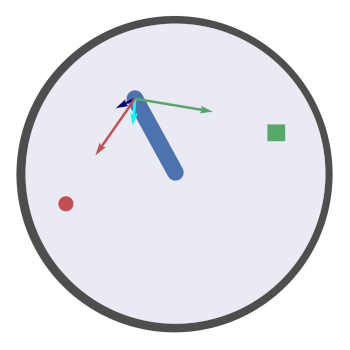Dynamic inference
dynamic hybrid models, trajectory inference, object grasping

This is the project related to the paper Dynamic inference by model reduction. This paper addresses the challenge of how intelligent agents can construct dynamic models of the world based on active inference. In particular, it proposes a hybrid method that uses a mixtures of Gaussians over movement trajectories in generalized coordinates, allowing the agent to infer intentions and plan movements in dynamic environments.
The code can be found here.
Video simulations
HowTo
Start the simulation
The simulation can be launched through main.py, either with the option -m for manual control, -i for the active inference agent. If no option is specified, the last one will be launched.
Plots can be generated through plot.py, either with the option -d for the belief trajectories, or -v for generating a video of the simulation.
The tasks are organized as follows:
- inference_extrinsic/: a basic 1-DoF agent has to infer which of two moving objects it is following; the dynamic inference is performed in extrinsic (e.g., Cartesian) coordinates;
- inference_intrinsic/: a basic 1-DoF agent has to infer which of two moving objects it is following; the dynamic inference is performed in intrfinsic (e.g., polar) coordinates;
- planning/: a 4-DoF arm with a 4-DoF hand has to grasp a moving object.
Advanced configuration
More advanced parameters can be manually set from config.py. Custom log names are set with the variable log_name. The number of trials and steps can be set with the variables n_trials and n_steps, respectively.
The parameter n_tau specifies the sampling time window used for evidence accumulation, while n_policy controls the length of the policies.
The parameter n_objects specifies the number of objects, which are defined in the class Objects in environment/objects.py.
Agent
The script simulation/inference.py contains a subclass of Window in environment/window.py, which is in turn a subclass pyglet.window.Window. The only overriden function is update, which defines the instructions to run in a single cycle. Specifically, the subclass Inference initializes the agent and the objects; during each update, it retrieves proprioceptive and visual observations through functions defined in environment/window.py, calls the function inference_step of the agent, and finally moves the arm and the objects.
The script brain.py defines the structure of the (deep) hierarchical hybrid model, along with the dynamics functions. The script ie.py contains the IE class corresponding to an Intrinsic/Extrinsic module, and defines the proprioceptive, visual, and extrinsic likelihood functions. The script unit.py contains the Unit class specifiying a single hybrid unit, and the Obs class defining an observation modality. These modular units can be linked in a multiple input and multiple output architecture as defined by the IE and Brain classes. Sensory evidence is accumulated in every unit until the next discrete step. Finally, the discrete model is described in discrete.py, which performs Bayesian model comparison depending on the hybrid units, and generate the new discrete hidden causes.
Every computation is performed by automatic differentiation through pytorch.
Useful trajectories computed during the simulations are stored through the class Log in environment/log.py.
Note that all the variables are normalized between -1 and 1 to ensure that every contribution to the belief updates has the same magnitude.
References
2023
- Dynamic Inference by Model ReductionbioRxiv, Oct 2023